There are many types of bugs that live in the water. These aquatic creatures are adapted to short or long underwater periods depending on their breathing mechanism.
Some of these bugs may bite. There’s a tendency to see predatory bugs in water as the only species that can bite. Many other bugs that eat algae might not be prone to biting.
There are a few types of bugs that are specifically known to bite regardless of their aquatic or semi-aquatic nature.
Other bugs that live in water may not bite. They can still cause distress as many assume all bugs that live in water bite.
Table of Contents
Bugs That Bite in Water
The following species spend most of their lives in water. Some of these bugs may also be seen outside water on occasion.
1. Backswimmers
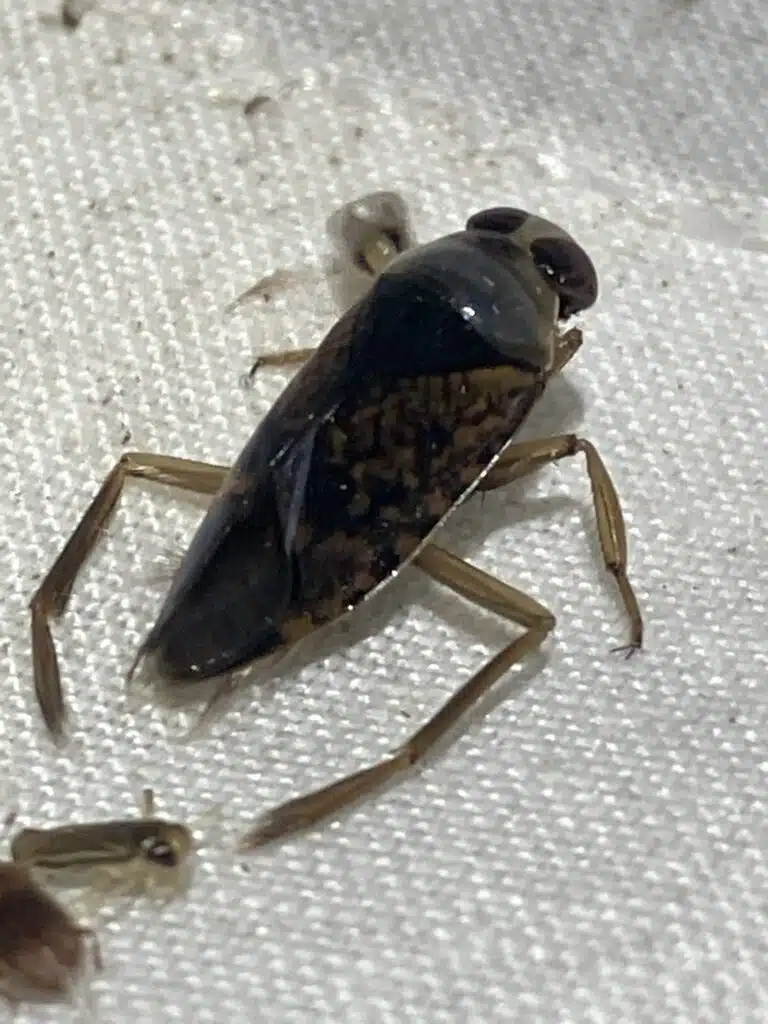
Backswimmers are some of the most common bugs in water that can bite. The bite of the species is painful.
The nature of this predatory bug is what makes it so dangerous. Backswimmers are a type of bugs that swim on their backs and this is a category that incorporates multiple species.
The Common Backswimmer is one of these species. This type of bug eats small fish and even tadpoles. It uses its long beak to inject toxic saliva into its prey.
Backswimmers can live in all bodies of water around the house. This includes any outdoor water tanks or pools your home might have.
2. Giant Water Bugs
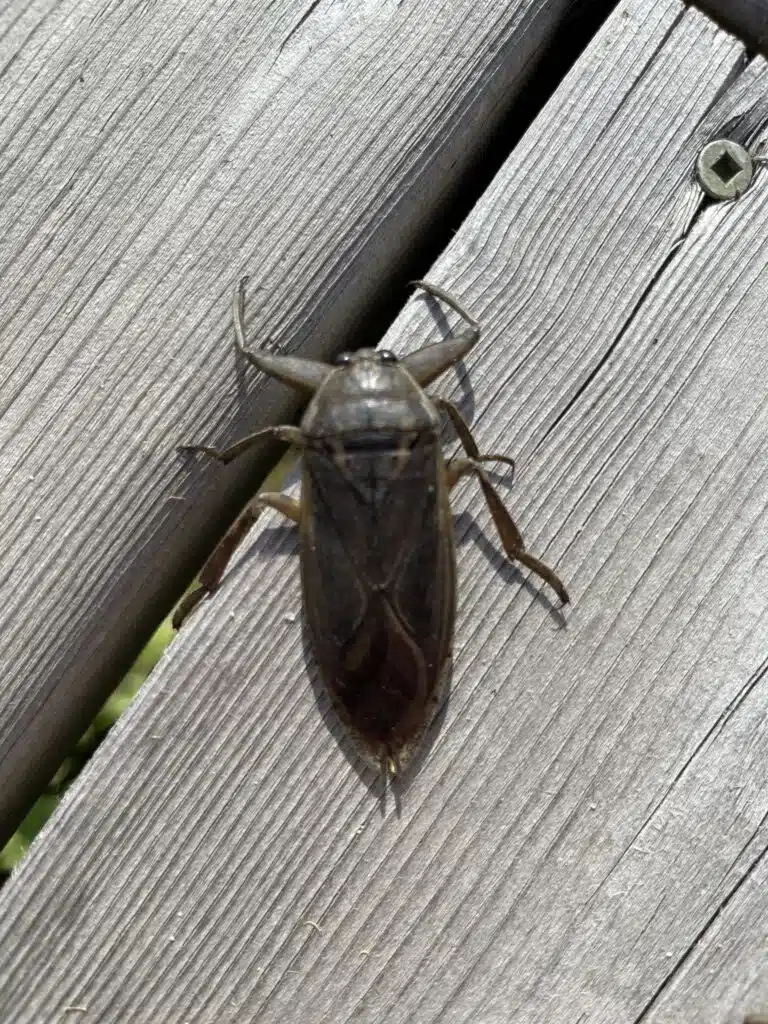
Giant Water Bugs are some of the largest bugs that live in water or next to the water.
These bugs grow to a size of up to 4.5 inches which makes them some of the most frequent predators in the water. They feed on various insects as well as invertebrates they can find in the water.
Crustaceans are a common meal for Giant Water bugs.
This species is identified by an oval shape and a brown body. The biggest issue with these bugs is they can bite.
The bite of the Giant Water bug is highly painful. While painful, this bite isn’t toxic or venomous.
People only suffer from short-lived acute pain when bitten by these bugs. As with Backswimmers, there are many sources of water the Giant Water Bug can live in.
Freshwater sources are preferred by this species. Ponds and streams are a common home to the species.
3. Water Scorpions
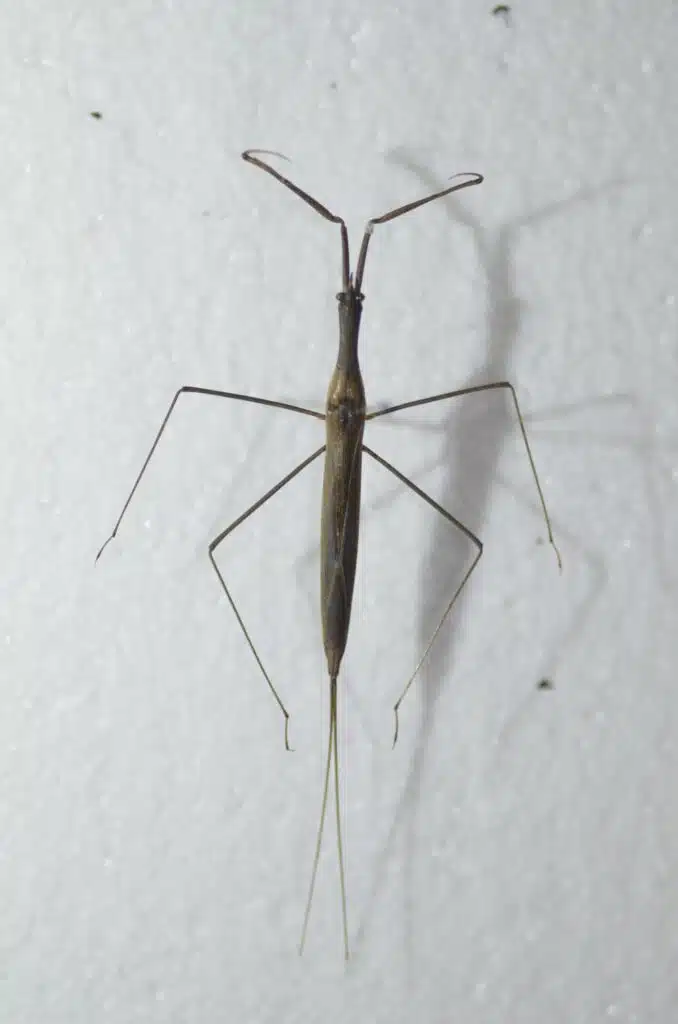
Growing to a size of up to a few inches, Water scorpions have a similar shape to Giant Water Bugs. These bugs are known for their oval shape, brown color, and ability to bite.
The bite of Water scorpions can be painful or very painful.
However, this type of bite isn’t one medical complication as the bite of a true scorpion.
Staying away from these bugs is also easier than from other water bugs as they don’t typically lay around pools and rivers as much as they aren’t very good swimmers.
Water scorpions attach themselves to vegetation to move along.
Large and slow-moving, the species can typically be avoided when spending time in ponds, marshes, or water canals.
4. Saucer Bugs
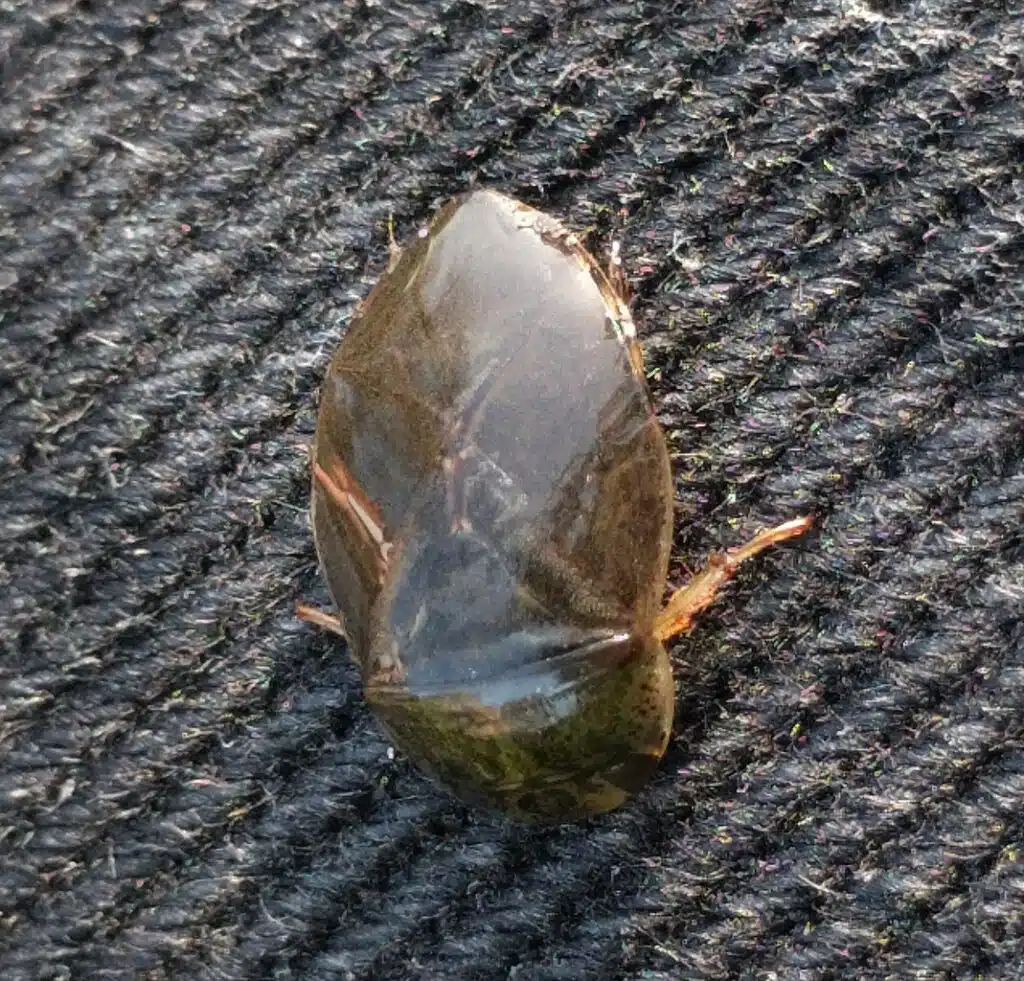
The sharp beak of the Saucer bug is also to be avoided as this species can pierce human skin.
While not as large as the Giant Water bug, Saucer bugs mimic these large bugs in appearance and behavior.
This mimicry includes biting.
Saucer bugs are considerably smaller than Giant Water bugs. They grow to a maximum size between 0.5 and 0.8 inches.
These bugs are also black and not brown. You can avoid these bugs when you see them in the water as there’s plenty of time to act since they move slowly.
However, chances of actually taking a bath out in water next to these bugs are slim since they prefer muddy or dirty waters.
5. Thrips
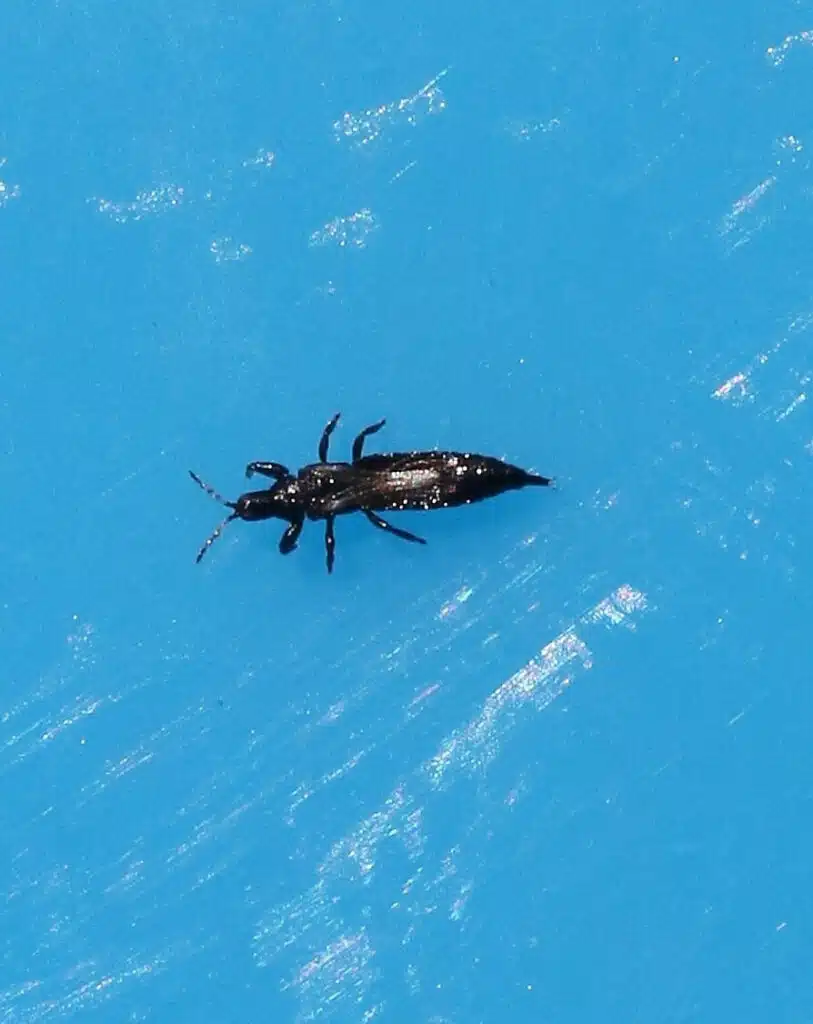
Thrips are some of the most versatile insects that live on land and in water. Thrips survive water contact and they might even seek it out for food.
These small insects feed on vegetation and infested vegetation.
They can move towards water sources to find new vegetation to feed on. Attracted to moisture, these insects may easily come in contact with humans since they can fly.
Thrips bite humans and their bite is painful. Higher chances of being bitten are reported on wet or sweaty skin as thrips are initially attracted by moisture.
6. Spiders
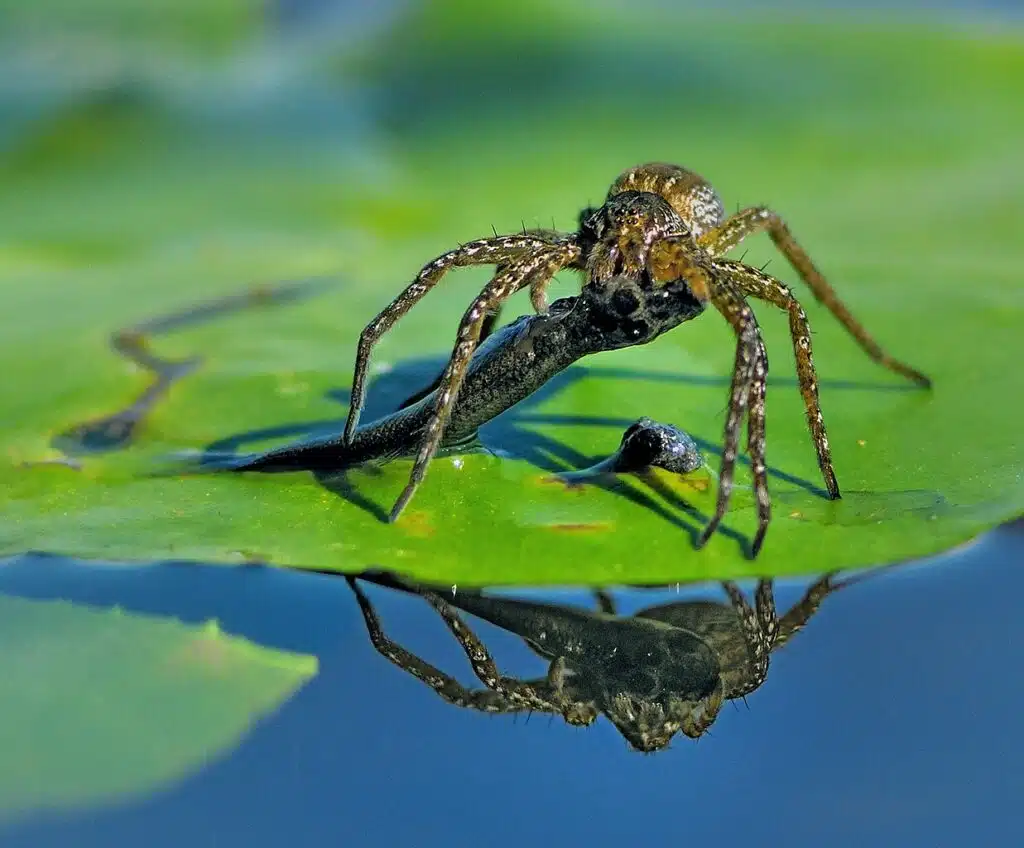
Spiders are common arachnids that live in or around water. Many water spiders can even bite.
The bite of these spiders isn’t as dangerous as the bite of other venomous spiders, but it can still be a painful experience.
Many types of fishing spiders that feed on insects and small fish are known to live around freshwaters such as lakes and streams.
You can also encounter diving spiders, a species that spends a considerable amount of time underwater.
Staying away from these biting spiders mostly involves staying away from puddling dirty water sources.
7. Ants
Most ants live on the ground. They move along looking for food and sometimes form colonies.
There are a few species of ants that can survive water and some have even adapted to rising water levels. Ants in the Amazon and Oceania such as the Polyrhachis sokolova are known to bite and survive complete submersion.
This species expects the tide to come in and sweep them away. They have adapted to holding their breath and to surviving tides before continuing with their lives.
You can stay away from these atypical ants by staying away from tidal mudflats in Australia.
8. Wasps
Wasps are some of the least likely insects to be seen underwater. However, there are at least a few known wasps that can go underwater and which may sting unlucky humans.
Trichopria Columbiana is among the parasitic wasps that can survive underwater.
The Microgaster Godzilla is also one of the few wasps demonstrated to dive underwater to lay eggs.
Wasps of this species can be completely submerged. They look for various caterpillars that live on surface-level vegetation on water.
Once located, the wasps dive into the water and come out from beneath the caterpillar to sting its soft underbelly and lay eggs inside a living host caterpillar.
What Else It Could Be
These are just some of the biting bugs that live in water or that survive total submersion.
There are many other species of bugs you might be afraid of when it comes to an aquatic habitat, but these bugs don’t bite.
1. Water Striders
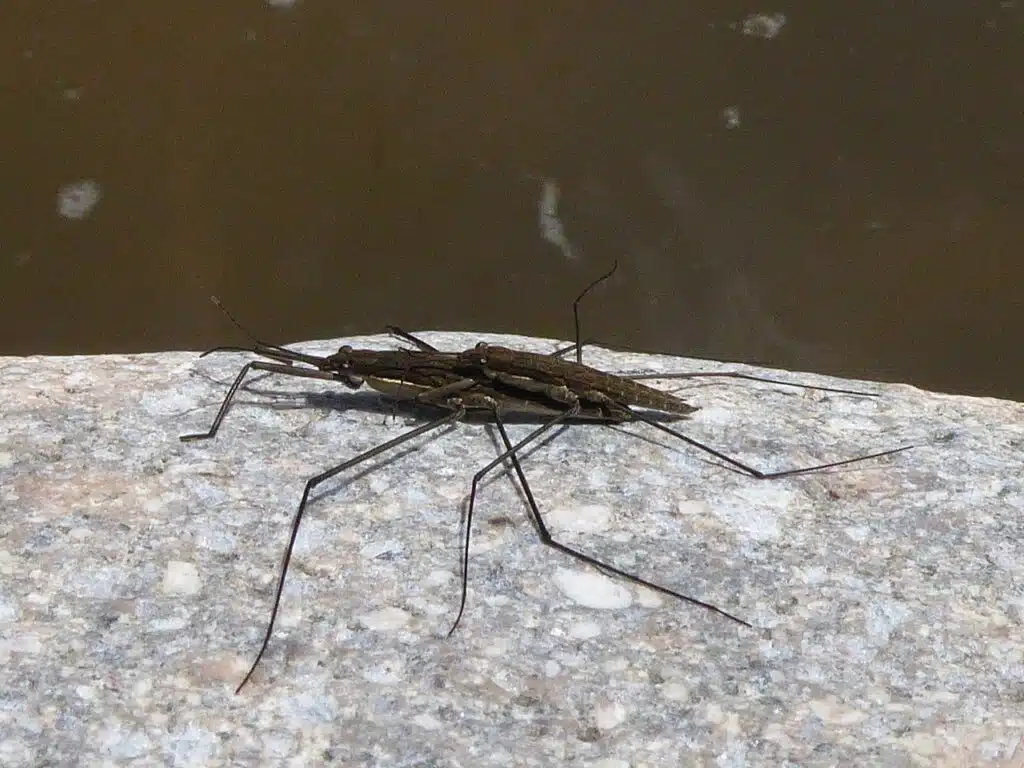
Water striders get their names from their hydrophobic capacities which repel water. This allows these bugs to walk on water without sinking.
You can identify these brown and dark gray bugs for walking on water rather than diving.
If you see Water striders it’s still best to clean the pool or the water tank they’re in. However, it’s not the time to panic as these bugs cannot sting.
2. Water Boatmen
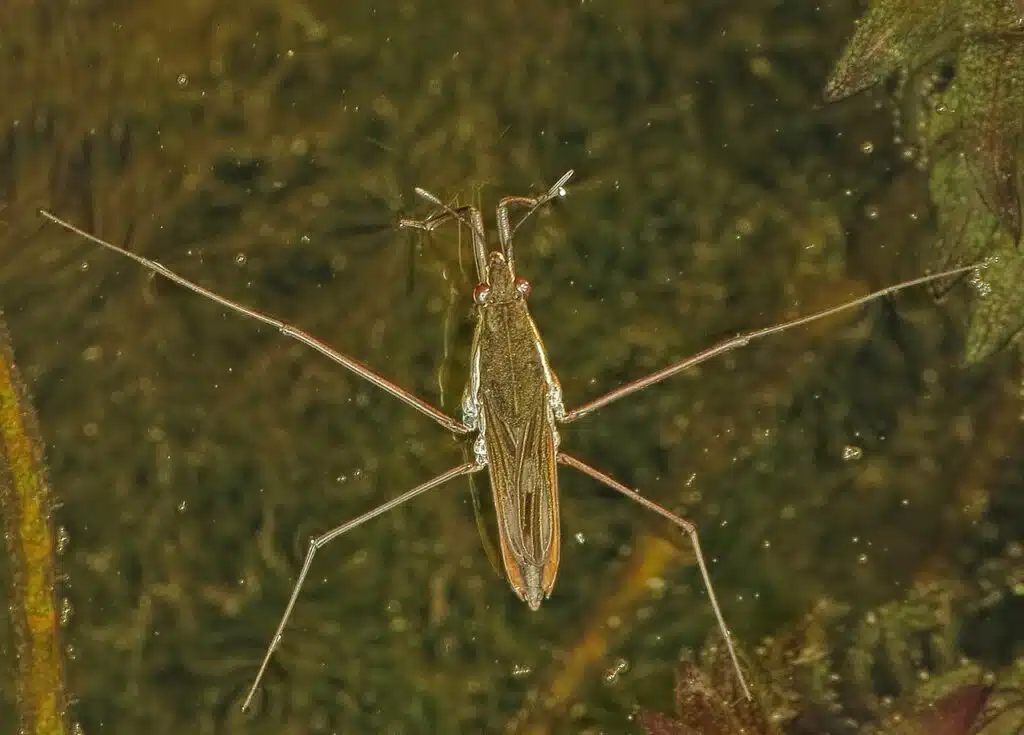
Water boatmen are among the species most commonly seen in pools around the house. You can identify the species by its dark color body and by its swimming position.
Water boatmen don’t swim upside down as backswimmers. These small bugs that grow to 15mm swim with their backs up.
Bugs of this genus don’t bite but they still indicate possible water quality issues.
Water boatmen are attracted to the algae in the water. They consume these algae as food.
The problem with water algae is that it already exists even when it’s not highly visible which is the case of green watercolor.
3. Springtails
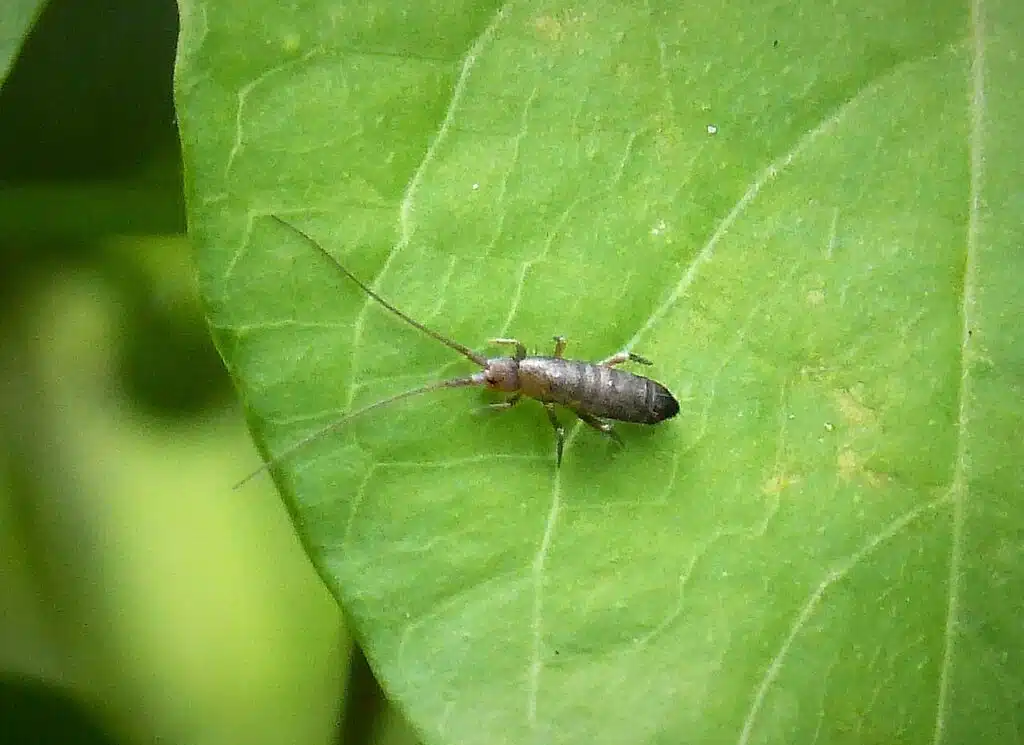
Springtails are omnivorous. These small insects eat almost anything they can find in moist locations.
Most springtails also have a natural capacity to swim or to remain afloat.
Springtails are some of the smallest insects on the water. They can be as small as 1/32 inches. While they have internal mouthparts, springtails don’t bite humans.
False belief springtails are skin parasites to humans has also become popular. However, it might be true that the fine hairs of springtails can lead to skin irritation.
4. Water Beetles
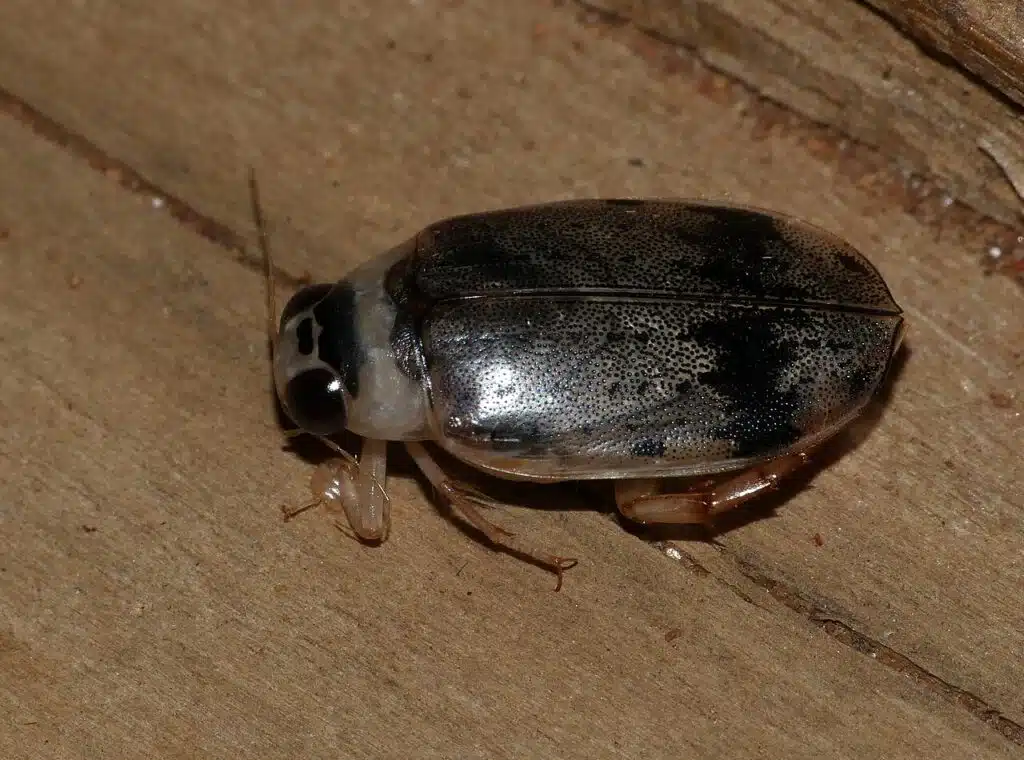
Water beetles are common all around the world. This category of bugs encompasses all types of beetles that live in water.
Most of these beetles are black or have a dark-color body.
These bugs don’t bite and they have very different feeding habits. They can be scavengers or they can be herbivorous feeding on water algae.
Water beetles can also be carnivorous mainly targeting insects on the water as food.
Water beetles stay afloat by trapping a small air bubble underneath the body.
5. Mayflies
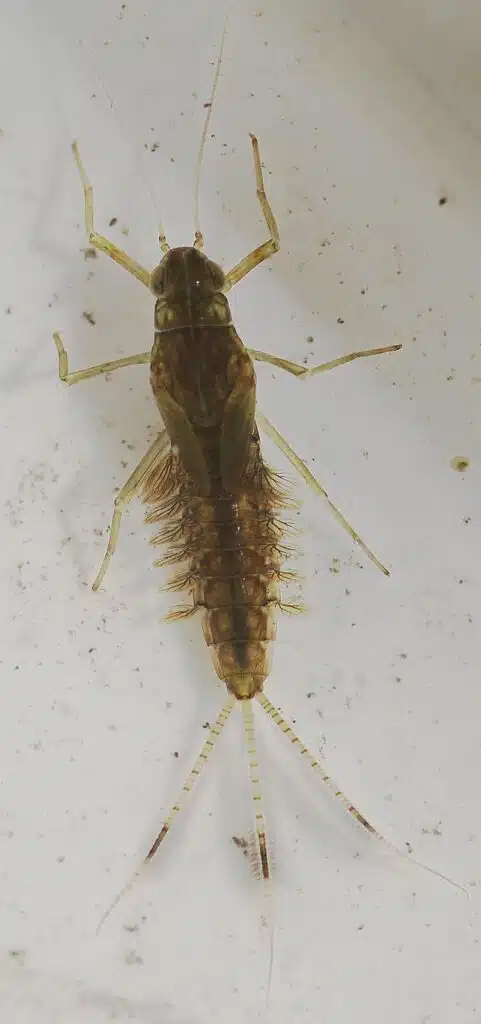
Mayflies are some of the oldest surviving insects in the world that can live on the water. Somewhat similar to springtails, mayflies have a clear pre-historic appearance which is also seen today.
You can identify mayflies by their transparent wings and 2 long tails which are often longer than the body of the species.
Mayflies feed and live around water sources such as ponds. These flies cannot bite and eliminating them from the pool or water tank is often based on similar techniques to mosquito elimination.
6. Dragonflies
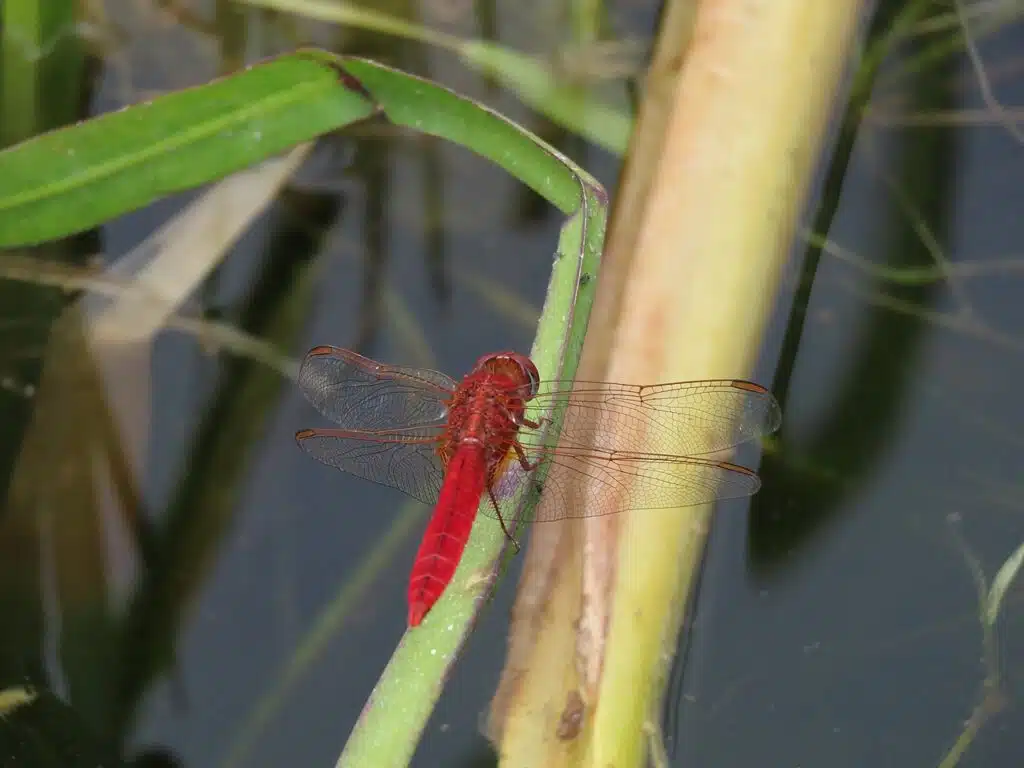
Dragonflies are identified by a combination of red, black, and yellow colors. They also have iridescent colors such as seen on the eyes of the fly.
Dragonflies live around water. They even use water to propel themselves up or to move faster.
Often seen on the surface of various freshwater bodies, dragonflies are also known for mating in the air.
Males and females remain attached while mating and they even fly together.
Dragonflies don’t bite but they are carnivorous as they eat all types of insects.
7. Damselflies
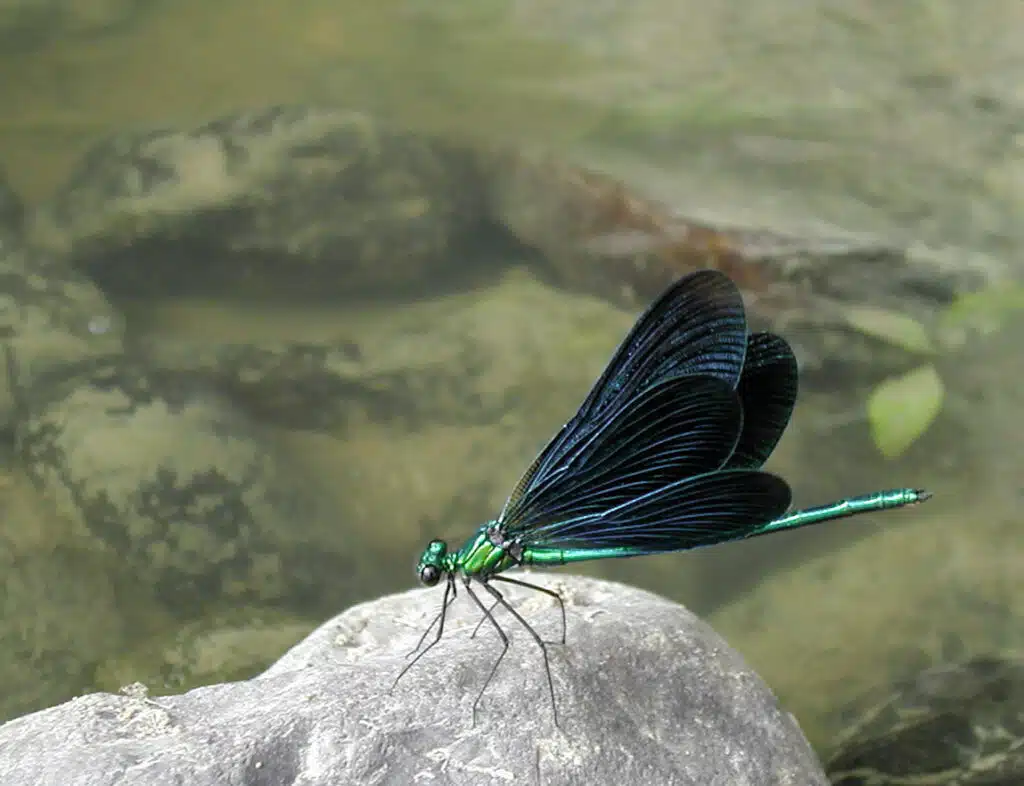
Damselflies are a type of common freshwater fly. They eat all types of insects they find around the water.
You can identify this species by their use of water to propel themselves similarly to dragonflies.
Damselflies are mostly blue, purple, black, and iridescent.
The colorful coloration of these flies can make some believe these flies can bite.
These types of flies lay eggs either directly in plants or directly underwater.
As a result, damselflies can submerge for a few minutes to lay eggs.
8. Caddisflies
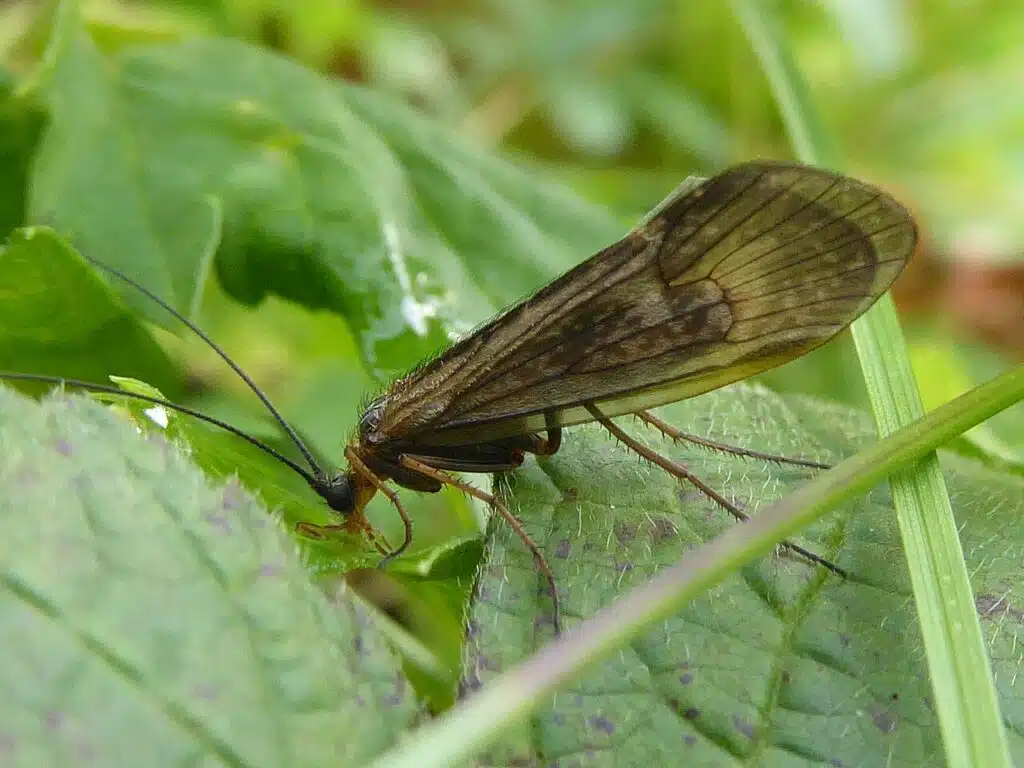
Caddisflies are small flies seen in freshwater. You can identify this species by having longer wings than the rest of the body, a rare trait among the list of possible bugs in water that bite.
Caddisflies don’t bite and they can be a positive water quality indicator.
These flies only live in clear water as they die in polluted water. Seeing Caddisflies in lakes or streams is an indication of water purity in those lakes and streams.
What to Do When You Are Bitten?
Getting bitten while in water isn’t pleasant. It can even be a highly painful experience.
In some cases, bites from water bugs can even lead to complications such as infections. A visit to the doctor might be mandatory in such cases.
Regardless of the severity of the bite, you still need to consider the following tips right after you realize you’ve been bitten.
Don’t scratch
The first reflex following any bug bite is to scratch. This is to be avoided at all costs as scratching can make things worse.
You can irritate your skin by scratching too much. Furthermore, you can start a skin-level infection by rubbing bacteria into the bitten area.
Since you cannot see bacteria it’s best not to scratch at all as this comes with all types of invisible risks. Even infested water can cause adverse skin reactions so it’s best not to scratch and to think about the alternative methods you have to reduce itching and relax the skin.
Apply a cold compress
Cold compresses are among the first solutions to reduce inflammation in the area of the bite.
You need to use clean tap water, distilled water, or saline water for your cold compress instead of using water straight from the place you’ve been bitten in.
Cold compresses need to be updated every few minutes right after the bite. This ensures the compresses remain cold throughout the process.
Tea compresses might also help in the case of mild skin reactions such as redness in the area of the bite. Anti-inflammatory tea types such as chamomile tea can be used to reduce itching and control mild skin-level inflammation.
Take painkillers
Painkillers can be recommended by a pharmacist following a bite in the water. You need to consider only taking the maximum daily recommended dosage of painkillers when it comes to home treatment.
Most people don’t need painkillers in the first place. It’s only those with pain that doesn’t subside that might need painkillers.
Doctors might also prescribe painkillers. You may need to purchase painkillers after a doctor’s visit if the bite reactions don’t subside within a few hours following the bites.
Antihistamines are also often recommended by doctors or pharmacists following water bug bites. As painkillers, antihistamines are also recommended whenever the symptoms don’t quickly subside.
Monitor skin health for a couple of days
It’s important to examine the skin a few times per day following the bite up to a few days afterward. This is an important stage where your skin might show signs of adverse reactions.
Red skin, swollen skin, or rashes that don’t go away are all signs of skin infection.
You need to eliminate the risk of infection by monitoring the health of the skin in the area of the bite and the immediate area as well.
It can take up to a few days for the bite symptoms to completely go away. In some cases, adverse reactions to these bites only appear after a few days.
If you think the health of the skin is at risk you may even take photos of your bitten area to have some type of visual proof to show at the nearest hospital.
Visit a doctor if the reactions are severe
Visiting a doctor isn’t always required whenever you get bitten in the water. Most doctor’s visits only happen when you start to see complications such as n infection.
On the other hand, you may want to limit risks and visit your doctor as soon as possible. These bugs rarely carry serious diseases but they may lead to mild infections you might want to stay away from.
Fever is one of the common reactions to infections and you may need to visit a doctor or a hospital if you see that you have a high body temperature following a water bug bite. This is a symptom of an infection.
Clean out the water source
You should always clean the water if you get bitten around your home after treating yourself.
Cleaning the pool is recommended if you’ve been bitten inside the pool. Water features, gazebos, and small lakes on your property also need to be regularly cleaned so they don’t house various water bugs.
Clear sign water needs to be filtered is seeing algae. Green water or water with even a slight green tint is already an indication that you need to filter or clean water so that bugs don’t bite you again.
How to Prevent Biting from Bugs in The Water
Preventing water bug bites can be easier than dealing with their consequences. In general, clean water and exercising caution before getting into a pond or lake to swim are sufficient to stay away from these bites.
Here’s a complete list of things to consider if you want to keep these bites away for good.
Keep a clean pool
The pool is one of the main areas where biting bugs live and mate around the house. Other open water tanks and containers may also be a home for these bugs around the house.
However, swimming in the pool comes with the highest chances of getting bitten since you get in the water right next to possibly biting buts.
A clean pool is a pool free from algae that attract herbivorous bugs which may attract predatory bugs in turn.
Water filtering systems and water cleaning treatments are recommended for all pools, especially those at home which don’t get regularly maintained as public pools.
Cover the pool when not in use
Another possible solution to prevent bugs that bite in the water is to cover the pool at night or when not in use.
Pool covers are affordable and efficient. They keep many bugs out and they also block out leaves, dust, and debris from setting in the water.
Covered pools might also be a good idea in bad weather when the wind can bring in all types of debris from the garden.
Use water filtration systems
Water filtration systems are mandatory for almost all bodies of water around the house. From small ponds to the pool, clean water is best at keeping bugs, water snakes, and other amphibians away.
You may need to invest in independent filtration systems. The good news is these filtration systems are mainly automatic so that you don’t need to heavily invest in them.
Cover outdoor water tanks
Large water tanks or rainwater tanks are common in areas without running water. These are breeding grounds for various water bugs.
Many water bugs can fly out of these containers and bite you even when you’re doing chores around the yard.
All water containers should be covered. Furthermore, covering large water containers also stops water from becoming green.
Don’t bathe in water with algae
Green water is a sign of high algae levels. Algae are a sign of trouble as they house a range of biting and non-biting bugs and insects.
You should never swim or bathe in green water. Some people believe only water in the pool can get green due to poor filtration.
However, green water or water with algae is also seen in many other areas and including rivers, lakes, and ponds. You should stay away from water that isn’t clear.
Refrain from swimming in lakes and rivers with dirty water
Lakes and rivers are natural habitats for swimming. However, they are also homes to more bugs than your backyard pool.
Many water spiders, bugs, and other insects that live and mate on the water are found here.
Rivers and lakes with plenty of overhanging vegetation are often the home of many biting and non-biting bugs. It’s often best to stay away from these areas.
Check for insects on the surface of the water
A simple visual check-up can help stay away from water bug bites. You may need to check the pool or an entire swimming area around a lake to see if there are any bugs around.
Visual inspection can help with surface-level bugs but it may not indicate the underwater bugs which may still be there. The more thorough the check-up the lesser the risks of being bitten.
Don’t swim in lakes or rivers next to pastures
Pastures and farmland next to water sources are a clear indication you should stay away. Drinking water from rivers and streams next to pastures isn’t allowed and so is swimming.
Animal feces get into the water either by direct contact or washed away by rain. This means the feces in the water attract all types of bugs and the risk of being bitten is high.
Furthermore, water around pastures and farmland is often contaminated. It may lead to skin infections if you get bitten.
Even a small bug bite in water with feces infestations can lead to major infections, high fever, nausea, and vomiting.
Some of the bugs that bite are attracted to feces which means they particularly seek out water next to pastures to lay eggs in.
Some of the wasps that live in water have been shown to prefer algae and vegetation-rich areas where many types of caterpillars hide to lay eggs in. It’s best to stay away from swimming in water that’s too close to farmland.
Summary
Backswimmers and Giant Water bugs are some of the most common bugs that bite. Various other species of bugs are also known to bite.
Some of the first signs of these bugs is seeing just one single water bug in water which is a signal there are more bugs nearby.
Water algae or green watercolor is another sign many bugs that bite might be lurking inside.
You can prevent getting bitten by bugs in water by always swimming in clear water and by cleaning your pool, a common home for water bugs and one of the most common places where bites are reported.
You can use water filtration filters and pool covers for your pool and all other exposed water tanks around the house to keep these bugs and their eggs out.
While not all bugs in water bite, they can attract carnivorous predatory bugs that can bite.